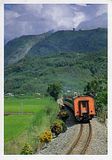
 Lake Balaton, located in Hungary, is the largest lake in Central Europe, and one of the foremost regional tourist destinations. Due to Hungary being landlocked, it is often affectionately called the "Hungarian Sea". The Zala River provides the largest inflow of water to the lake, and the canalized Sió is the only outflow. With a surface area of 592 km² has a length of 77 km and a width ranging from 4 to 14 km. The lake's surface is 104 m above sea level, and its depth varies up to 12,2 m (mean depth is 3,2 m).
Lake Balaton, located in Hungary, is the largest lake in Central Europe, and one of the foremost regional tourist destinations. Due to Hungary being landlocked, it is often affectionately called the "Hungarian Sea". The Zala River provides the largest inflow of water to the lake, and the canalized Sió is the only outflow. With a surface area of 592 km² has a length of 77 km and a width ranging from 4 to 14 km. The lake's surface is 104 m above sea level, and its depth varies up to 12,2 m (mean depth is 3,2 m).In Hungarian, the lake is known as Balaton (nicknamed Balcsi, and sometimes "The Hungarian Sea"); in Latin as Lacus Pelso, in German as Plattensee, in Slovak as Blatenské jazero and in Croatian and Serbian as Blatno jezero.
Its name means approximately "muddy lake" in Slavic ("blato" means "mud" in South-Slavic from earlier Pan-Slavic "bolto"). The Hungarian name Balaton, is also derived from the original Slavic name (Slavic neutrum adjective "boltьno(-je ezero)" = "muddy (lake)"), but it has no concrete meaning today in Hungarian.
The Romans called the lake Lacus Pelso ("Lake Pelso"). Pelso derives from a local name for the lake, perhaps from the Illyrian language, the Illyrians having once populated the region. Paleolinguists surmise that "Pelso" meant "shallow" in Illyrian, this deduction being based on its probable Proto-Indo-European root *pels-, and on examples such as Plattensee ("shallow sea"), a name given to the lake by the Germanic people in the area through the centuries.
Its name means approximately "muddy lake" in Slavic ("blato" means "mud" in South-Slavic from earlier Pan-Slavic "bolto"). The Hungarian name Balaton, is also derived from the original Slavic name (Slavic neutrum adjective "boltьno(-je ezero)" = "muddy (lake)"), but it has no concrete meaning today in Hungarian.
The Romans called the lake Lacus Pelso ("Lake Pelso"). Pelso derives from a local name for the lake, perhaps from the Illyrian language, the Illyrians having once populated the region. Paleolinguists surmise that "Pelso" meant "shallow" in Illyrian, this deduction being based on its probable Proto-Indo-European root *pels-, and on examples such as Plattensee ("shallow sea"), a name given to the lake by the Germanic people in the area through the centuries.































No comments:
Post a Comment